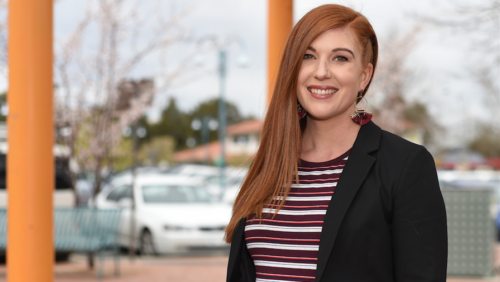
ADRIENNE Hornby did everything right when it came to the five key rules of sun safety and yet at the beginning of the year, she was devastated to hear about the stage 1 melanoma on her forehead.
“My mum drilled into me the importance of sun protection from a young age,” says Adrienne, 32, of Coombs, who lost her mum to a stage 4 melanoma when she was 21.
“I always kept out of the sun, especially because of my fair skin.”
But all it takes is one mole, says Adrienne, who emphasised this when she spoke about the “deadliest cancer for young people” to teenagers from 10 Canberra high schools as part of a SunSafe program in Campbell last week.
Run by the Melanoma Institute Australia, the peer-to-peer SunSafe Student Ambassador Program teaches students about the importance of sun safety and early detection so they can take the messages back to their schools.
Melanoma is often seen as an older person’s disease but it’s the most common cancer for 15 to 39-year-olds – a fact not many people understand or know, according to Melanoma Institute Australia CEO Matthew Browne.
Adrienne knows this statistic well, and even though she’s been vigilant her whole life, still developed a stage 1 melanoma.
While she was lucky to catch her melanoma early, she says her mum wasn’t, and was diagnosed with a stage 3 melanoma when Adrienne was six.
When Adrienne’s mum was younger she lived in the Cocos (Keeling) Islands, off Perth, and in Cairns during a time where “baking” in the sun was a thing people did.
She was in her 40s when media started highlighting melanomas and saying what to look for and, with a mole on her knee, Adrienne’s mum went to about six different doctors, who all said it was fine until a specialist told her it was a melanoma.
It had spread from her knee to her hips and the lymphatic system, and even though it was cut out and she was in remission for years, it came back worse than before when Adrienne was 21.
“Surgeons went in and had a look and removed the tumour from her abdomen,” she says.
“She went on to recover and then when they went back in, it had grown four times the size and had seeded to other organs.”
At that stage Adrienne’s mum was told it had become stage 4 and was terminal.
“She had six months to live and it eventually went to all of her organs,” says Adrienne, who was horrified to lose her mum so suddenly but says it gave her the ultimate gift of vigilance.
“Because of her, I applied all the sun-smart strategies when in the sun and maintained regular skin checks over the years and it ultimately saved my life,” she says.
Earlier this year Adrienne was prompted to go and see a doctor when the mole on her forehead started to get darker and the edges become discoloured.
A seven-week pregnant Adrienne (after two years of IVF attempts) was shocked to discover she had a stage 1 melanoma.
She says it was a scary possibility to think it could be the same cancer her mum died from.
“There was no rationality in it. I instantly thought, I watched someone die from it so it will happen to me,” she says.
“But because I noticed it so quickly, there’s a 92 per cent chance it will never recur. It can seed at any stage but family history doesn’t mean it will.”
Adrienne can’t get any scans until she’s had her baby but once he’s born she says she’ll get them to give her some peace of mind.
But until then Adrienne wants to raise awareness for others to get checked, too.
“I’m the most vigilant person when it comes to melanomas and this happened to me, so what about the people who aren’t?” she says.
And, the full-time primary school executive teacher, part-time health coach, says her experience has alerted her of the misinformation around vitamin D, which might affect someone’s chance of getting melanoma.
“For someone with fair skin, there’s no such thing as sensible sun exposure,” she says.
“I fell into the trap of the idea of sensible sun exposure.”
Adrienne says a lot of the advice is coming from podcasts or health experts from around the world where the sun isn’t as harsh as here.
“There is no global recommendation for sun exposure,” she says.
“[And] there’s others way to get vitamin D from diet and supplementation.”
The Melanoma Institute of Australia hopes so as well, which is why it’s been targeting sun-safety education at teenagers.
“The sun-smart program tends to stop at the end of primary school and we saw an opportunity to target young teenagers who are very influential,” Matthew says.
“The important thing is 90 per cent of melanoma is largely preventable by undertaking five simple rules of sun safety.”
The five rules of sun safety are:
- Wear a broad brimmed hat.
- Wear 50 plus sunscreen.
- Seek shade during the worst parts of the day (9am-3pm).
- Wear protective clothing such as long sleeved shirts and pants.
- Wear sunglasses.
Who can be trusted?
In a world of spin and confusion, there’s never been a more important time to support independent journalism in Canberra.
If you trust our work online and want to enforce the power of independent voices, I invite you to make a small contribution.
Every dollar of support is invested back into our journalism to help keep citynews.com.au strong and free.
Thank you,
Ian Meikle, editor





Leave a Reply